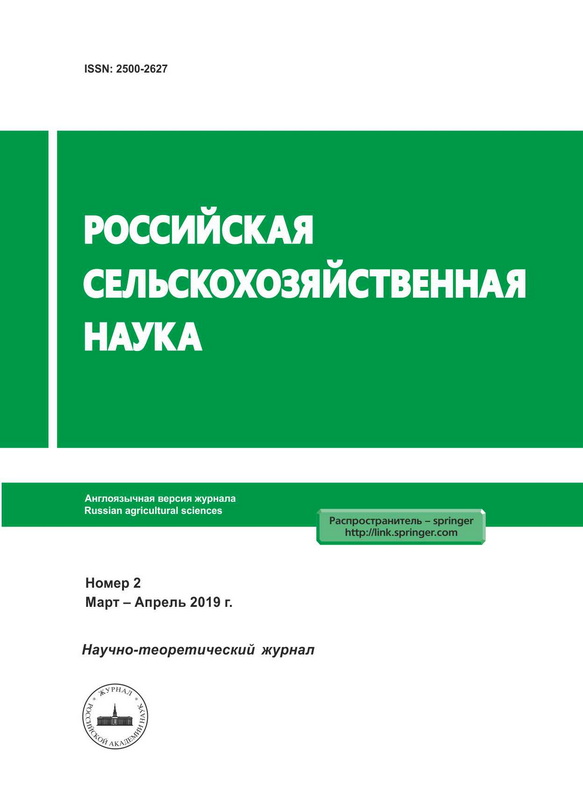Инновационные приемы молекулярной cелекции сахарной свеклы
- Авторы: Богачева Н.Н.1, Федулова Т.П.1, Налбандян А.А.1
-
Учреждения:
- Всероссийский научно-исследовательский институт сахарной свеклы и сахара имени А.Л. Мазлумова
- Выпуск: № 2 (2019)
- Страницы: 15-18
- Раздел: Растениеводство
- URL: https://journals.eco-vector.com/2500-2627/article/view/15545
- DOI: https://doi.org/10.31857/S2500-26272019215-18
- ID: 15545
Цитировать
Полный текст
Аннотация
Проведен молекулярно-генетический отбор родительских линий сахарной свеклы для гибридизации. Представлены результаты молекулярной оценки исходных линий по микросателлитным маркерам. Объектом исследования были растения мужскостерильных линий и линий многосемянных опылителей. В результате исследования полиморфизма 12 микросателлитных маркеров отобраны 2 пары праймеров: Bvv 30 + Bvv 64 и Bvv 23 + Bvv 32 как наиболее информативных для выявления гетерогенности исходного материала и эффективных для прогнозирования гетерозиса. ПЦР-анализ 12 исходных линий сахарной свеклы с этими парами микросателлитных праймеров позволил определить специфические ДНК-профили для селекционного материала. Выявлены генетические расстояния и проведен кластерный анализ, позволившие дифференцировать изученные сортообразцы на кластеры в зависимости от генетического родства. Рекомендованы родительские формы для скрещиваний с целью создания высокопродуктивных гибридов. Установлено, что скрещивание линий, наиболее генетически отдаленных друг от друга, играет важную роль в проявлении эффекта гетерозиса у гибридов. Гибридные комбинации с генетическим расстоянием менее 1,41 целесообразно исключать из дальнейшего изучения в связи с низкой продуктивностью. Представленные результаты исследований имеют значение для практической селекции сахарной свеклы при создании гетерозисных гибридов.
Ключевые слова
Об авторах
Н. Н. Богачева
Всероссийский научно-исследовательский институт сахарной свеклы и сахара имени А.Л. Мазлумова
Автор, ответственный за переписку.
Email: arpnal@rambler.ru
кандидат биологических наук
Россия, Рамонский район, п. ВНИИССТ. П. Федулова
Всероссийский научно-исследовательский институт сахарной свеклы и сахара имени А.Л. Мазлумова
Email: arpnal@rambler.ru
доктор биологических наук
Россия, Рамонский район, п. ВНИИССА. А. Налбандян
Всероссийский научно-исследовательский институт сахарной свеклы и сахара имени А.Л. Мазлумова
Email: arpnal@rambler.ru
кандидат биологических наук
Россия, Рамонский район, п. ВНИИСССписок литературы
- Gärtner T.,Steinfath M., Andorf S., Lisec Jan, Meyer Rhonda C., Altmann Th., Willmitzer L., Selbig J.Improved Heterosis Prediction by Combining Information on DNAand Metabolic Markers // PLoS One.– 2009. –4 (4).
- Srivastava S., Pathak A., Kumar R., Joshi B. Genetic diversity of sugar beet genotypes evaluated by microsatellite DNA markers // Journal of Environmental Biology. – 2017. – V.37. – P 777-783.
- Iquebal M., Jaiswal S., Angadi U., Sablok G., Arora V. SBMDb: first whole genome putative microsatellite DNA marker database of sugarbeet for bioenergy and industrial application // Database. –2015. – V.111. – P.1-10.
- Izzatullayeva V., Akparov Z., Babayeva S., Ojaghi D. Efficiency of using RAPD and ISSR markers in evaluation genetic diversity in sugar beet // Turkish Journal of Biology. – 2014. – V.38. – P.429-438.
- Zakrzewski F., Wenke T., Holtgrawe D.,Weisshaar B., Schmidt Th. Analysis of a Cot-1 library enables the targeted identification of minisatellite and satellite families in Beta vulgaris // BMC Plant Biology. –2010. – V.10. – 8. – P.5-14.
- Хемлебен В.,Беридзе Т.Г., Бахман Л., Коварик Я., Торрес Р. Сателлитные ДНК // Успехи биологической химии. –2003. – Т.43. – С. 267-306.
- Sandhu S., Sarao N., Goyal M., Uppal SK. Profiling of sugar beet genotypes for agronomical, sugar quality and forage traits and their genetic diversity analysis using SSR markers // Electronic Journal of Plant Breeding. –2015. – V.7. – P. 253-266.
- Taski-Ajdukovic K., Nagi N., Curcic Z., Zoric M. Estimation of genetic diversity and relationship in sugar beet pollinators based on SSR markers // Electronic Journal of Biotechnology. –2017. – V.27. – P. 1-7.
- Abbasi Z., Arzani A., Majidi M. Evaluation of Genetic Diversity of Sugar Beet (Beta vulgaris L.) Crossing Parents Using Agro-morphological Traits and Molecular Markers // J. Agr. Sci. – 2014. – V.16. – P. 1397-1411.
- Stancic I., Zivic J., Petrovic S., Knezevic D. Impact of Genes and Proportional Contribution of Parental Genotypes to Inheritance of Root Yield and Sugar Content in Diploid Hybrids of Sugar Beet // The Scientific World Journal. –2014. – Article ID 580623. – P. 1-5.
- Chomczynski P.,Sacchi N. Single-StepMetod of RNA Isolation by Acid Guanidinium Thiocyanate-Phenol- Chloroform Extraction // Anal. Biochem. – 1987. – V.162. – P. 156-159.
- Rogers, S.O., Bendich A.J. Extraction of DNA from milligram amounts of fresh, herbarium and mummified plant tissues // Plant Molecular Biologi. – 1985. – V.5. – P. 69-67.
- Smulders M.J.M., Esselink G.D., Everaert I., Riek J.De, Vosman B. Characterisation of sugar beet (Beta vulgaris L. ssp. vulgaris) varieties using microsatellite markers // ВМС Genetics. – 2010. – V.11(41). – P. 1-11.
- Омаров, Д.С. К методике учета и оценки гетерозиса у растений // С.-х. биология. – 1975. – Т.10. – № 1. – C. 123–127. 15. Хуссейн А.С., Богачева Н.Н., Налбандян А.А. Полиморфизм селекционных линий сахарной свеклы по микро- сателлитным локусам //Доклады Российской акаде- мии сельскохозяйственных наук. – 2016. – №2-3. – С. 10-13.
Дополнительные файлы









